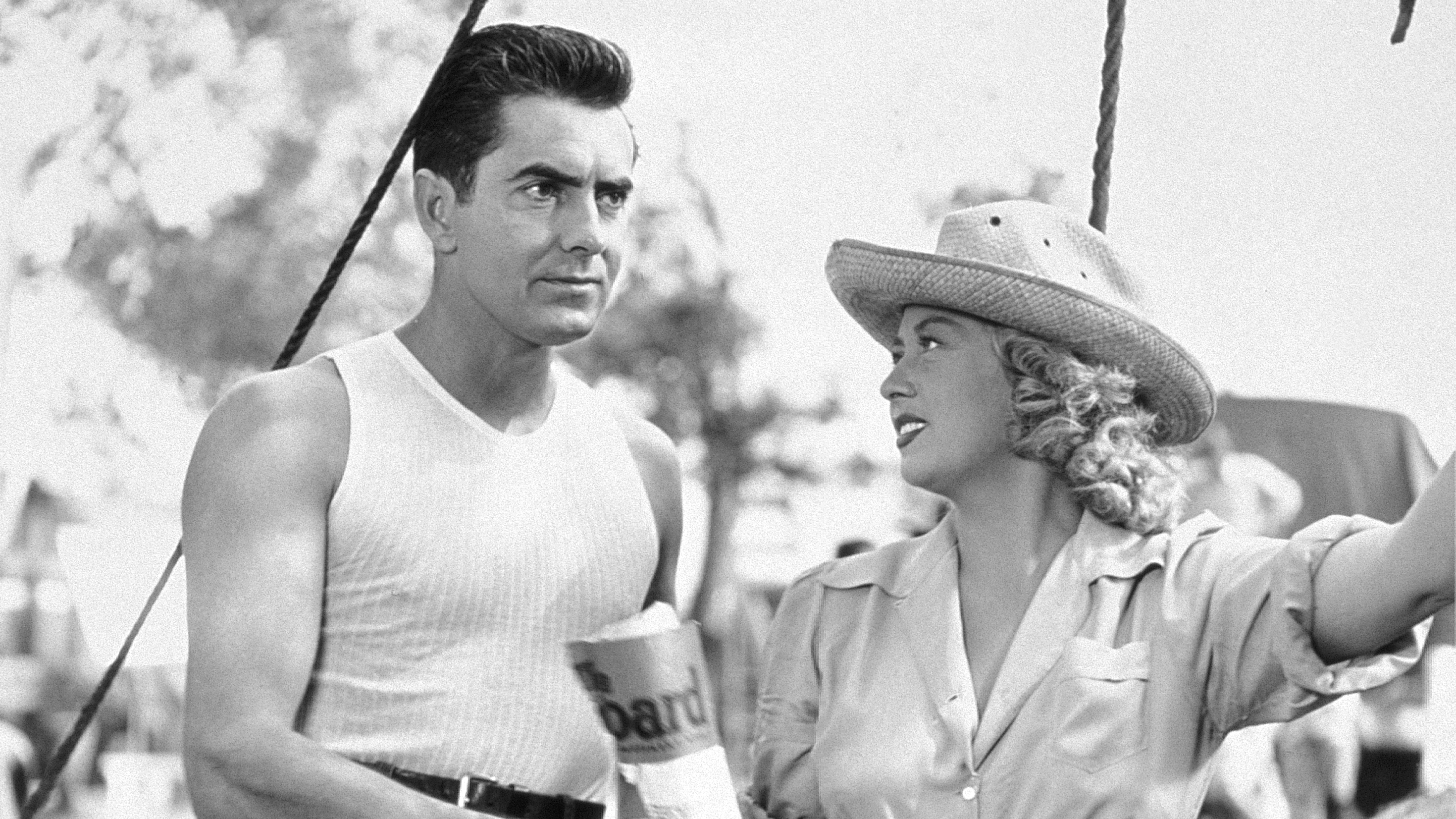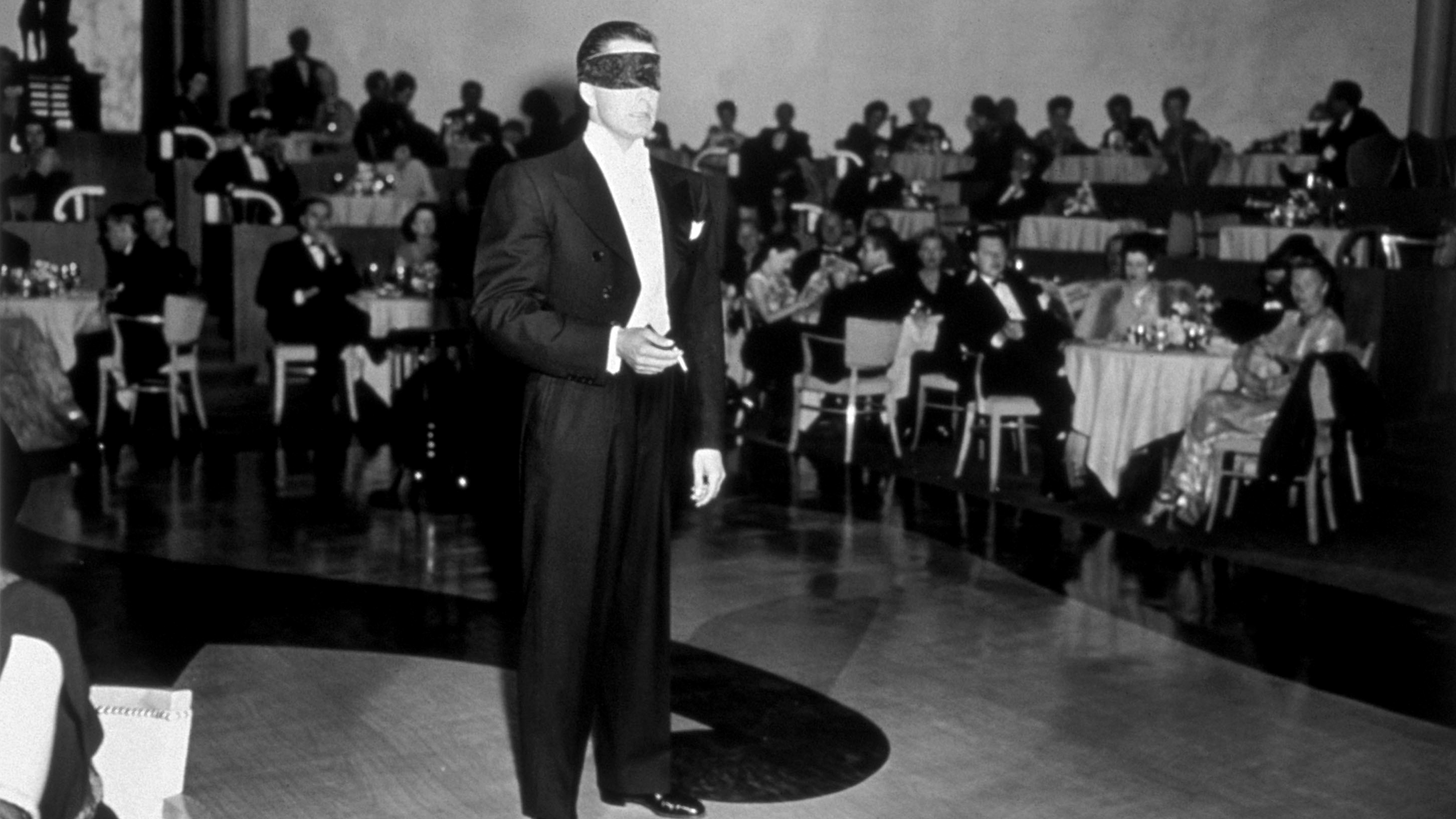CLOSING NIGHT:
NIGHTMARE ALLEY (1947)




7:45 PM, Sunday May 01
Premiere: Introduced by James Vaughan
10:45 AM, Tuesday May 03
Randwick Ritz
Director: Edmund Goulding
Country: USA
Year: 1947
Runtime: 110 minutes
Rating: M
Language: English
TICKETS ⟶
Premiere: Introduced by James Vaughan
10:45 AM, Tuesday May 03
Randwick Ritz
Director: Edmund Goulding
Country: USA
Year: 1947
Runtime: 110 minutes
Rating: M
Language: English
TICKETS ⟶
“THIS RAW, BITTER DRAMA OF THE TOUGHER SIDE OF TRAVELLING CARNIVAL LIFE MAKES FEW CONCESSIONS” – DAILY TELEGRAPH (AUS)
Usually cast as a romantic lead, Tyrone Power goes well against type as a carnival worker who uses the codes of a fake mind reader to become a dinner-suited, blindfolded ‘mentalist’ in a reputable Chicago night club.
Carny life at its most realistic, this film noir exposes the ‘lower depths’ of the entertainment world and has grown in reputation. Recently remade with a cast including Bradley Cooper, Cate Blanchett and Rooney Mara. Here’s a chance to see the original in a brand new 4K restoration on the big screen.
“The characterizations in Nightmare Alley are studies in film noir. People are shown as venal, gullible, and obsessed with success at any price.” – Joan Cohen
“One of those films mentioned in lowered voices, a guilty secret, to be screened at midnight behind closed doors…”
– John Baxter
Introduced by James Vaughan, film-maker, director of Friends and Strangers (2021), Member of the Cinema Reborn Organising Committee.
Usually cast as a romantic lead, Tyrone Power goes well against type as a carnival worker who uses the codes of a fake mind reader to become a dinner-suited, blindfolded ‘mentalist’ in a reputable Chicago night club.
Carny life at its most realistic, this film noir exposes the ‘lower depths’ of the entertainment world and has grown in reputation. Recently remade with a cast including Bradley Cooper, Cate Blanchett and Rooney Mara. Here’s a chance to see the original in a brand new 4K restoration on the big screen.
“The characterizations in Nightmare Alley are studies in film noir. People are shown as venal, gullible, and obsessed with success at any price.” – Joan Cohen
“One of those films mentioned in lowered voices, a guilty secret, to be screened at midnight behind closed doors…”
– John Baxter
Introduced by James Vaughan, film-maker, director of Friends and Strangers (2021), Member of the Cinema Reborn Organising Committee.
FILM NOTES
By John Baxter
Edmund Goulding:
London-born Edmund Goulding had been a successful actor, playwright, stage director and songwriter (Mam’zelle; Love, Your Magic Spell is Everywhere) before emigrating to the U.S. in 1921. Hired as a screenwriter/director by MGM in 1925, he won a reputation for tasteful, cultured dramas and drawing-room comedies. After directing Greta Garbo, Joan Crawford and John Barrymore in Grand Hotel, he moved to Warner Brothers, where he worked with Bette Davis on Dark Victory, The Old Maid and Of Human Bondage, then to Twentieth Century-Fox, for whom he directed Charles Boyer and Joan Fontaine in The Constant Nymph and Tyrone Power in The Razor’s Edge and Nightmare Alley.
Goulding’s films typified the elegance and refinement Hollywood associated with London theatre. He played up to his reputation with meticulous craftsmanship. The classic “hands-on” director, he performed, according to his biographer, “multiple functions on each set... co-wrote many scripts, composed incidental music, produced, even consulted on makeup, costumes, and hair styling.” His habit of miming performances for his stars before the cameras rolled annoyed such sticklers for motivation as Boyer but won Academy Awards and box office success for them and for their films, though Goulding would never win the Oscar for Best Director which he coveted and, most agreed, richly deserved.
Goulding’s films typified the elegance and refinement Hollywood associated with London theatre. He played up to his reputation with meticulous craftsmanship. The classic “hands-on” director, he performed, according to his biographer, “multiple functions on each set... co-wrote many scripts, composed incidental music, produced, even consulted on makeup, costumes, and hair styling.” His habit of miming performances for his stars before the cameras rolled annoyed such sticklers for motivation as Boyer but won Academy Awards and box office success for them and for their films, though Goulding would never win the Oscar for Best Director which he coveted and, most agreed, richly deserved.
The Film:
In the dark days before DVDs, Nightmare Alley was one of those films mentioned in lowered voices, a guilty secret, to be screened at midnight behind closed doors. Even today, it remains astonishing that a major studio, Twentieth Century-Fox, at a time when censors were determined to root out anything abnormal, should have featured a major star in a film of such Sartreian bleakness.
But Tyrone Power, then at the peak of his fame as a romantic hero, hungered for Significance. He bullied studio boss Darryl Zanuck into buying William Lindsay Gresham’s novel and assigning one of his most trusted directors, Edmund Goulding. Zanuck, loathing the result, insisted on a sort-of-happy ending but did his best to suppress the film entirely, while Power’s early death ensured that it spent decades in obscurity.
The alley of the title is the midway of a cheap travelling carnival, a jumble of sideshows that strive to astonish, dismay and delude the public into paying to peek behind their tattered curtains. For fortune-teller Zeena (Joan Blondell) and her husband and partner Pete (Ian Keith), this is the end of the line. The only job lower in prestige is that of The Geek, a freak who lives in a pit and, sustained by cheap booze, both entertains and horrifies punters by biting the heads off live chickens.
“How could anyone sink so low?” muses roustabout Stan Carlisle (Power), a narrative promissory note to be redeemed in due course, and at compound interest.
In professional terms, Nightmare Alley was somewhere between salon des réfuses and scrap-yard. The career of producer George Jessel, a former vaudeville comic turned doyen of Hollywood’s club, roast, benefit and banquet scene, never recovered after he declined the role in The Jazz Singer that launched talking pictures and made Al Jolson a star.
Screenwriter Jules Furthman and cinematographer Lee Garmes were renegades, rebels against the prevailing factory style, often brought in on contentious projects as an excuse for the studio to disavow the result if they disliked it. Furthman worked frequently with notoriously difficult director Josef von Sternberg, notably on Shanghai Express, a film also lit by Garmes, who won an Oscar for his work.
Joan Blondell, as the blowsy, knowing Zeena, had just turned forty, and made no effort to disguise the fact, while Ian Keith was winding up a long career spent on Broadway and in films opposite such stars as Gloria Swanson and Greta Garbo.
Goulding skilfully offers us hints of the couple’s former celebrity. For Zeena’s first appearance, he poses Blondell statuesquely in the quasi-antique robes of her act, her dignity belying the cheap painted backdrop against which she leans.
Keith’s moment comes as Pete recalls for Stan, with a whisky bottle as his crystal ball, the spiel that once held audiences spellbound: (“They sat through six acts just to see us.”) Leaning towards the light, he falls into character. “Is it some quality of the crystal itself?” he murmurs. “Or does the gazer use the crystal to gaze... inwards? Who knows? But visions come...”
Stan uses his emerging skills to bamboozle a redneck sheriff (James Burke) intent on shutting down the show, distracting the lawman with the apparition of a near-naked Molly, seated in an electric chair, weaving ropes of high voltage between her hands like a skein of wool. Dazed by the sight, he’s easily mesmerised by Stan’s rambling monologue of pious clichés.
For Stan, raised in institutions, the carnival is the only secure community he has ever known, but he soon chafes at its restrictions. Eager for advancement, he wheedles from Zeena the word code that was the secret of their act. He also steals Molly (Colleen Gray), the not-very-bright girlfriend of strongman Mike Mazurki, and, with her as his assistant, becomes The Great Stanton, a suave operator in tails, dazzling patrons of a sleek city cabaret – called, improbably, The Spode Room..
In fashionable psychoanalyst Lilith Ritter (Helen Walker), Stan recognises a fellow trickster, and uses her to con Ezra Grindle (Taylor Holmes), a millionaire haunted by memories of a childhood love who died young; (during an abortion, the novel reveals, a detail dropped from the film.)
The lighting of Nightmare Alley is a tour de force of film noir atmospherics. Hardly a scene takes place in daylight. The carnival lives in darkness, as does Stan. A creature of the night, he strolls in from the hazy, ill-defined outer world to move easily among the tents and caravans, pausing briefly, face bisected by a razor-sharp shadow, before fading again into the dark.
He’s ill at ease in the rigid precision of Lilith Ritter’s world. For a scene in her office, Garmes employs a technique learned from von Sternberg on Morocco, illuminating Power from above in slatted light that imprisons him in bars of shadow. He’s more at home in the moon-lit garden where an apparition in Edwardian costume emerges from the shadows, with wide hat and parasol, to delude his victim into cringing contrition for an ancient sin.
Gresham was as much a loner and outcast as Stan Carlisle. Like his contemporary, Dashiell Hammett, he wrote for the pulp crime magazines, was politically far to the left, as well as being an alcoholic and sufferer from then-incurable tuberculosis. He died at 53, a suicide, in the New York hotel where he wrote the only one of his four books to show a profit. Police searching his body found some business cards. Under his name, they announced "No Address. No Phone. No Business. No Money. Retired."
But Tyrone Power, then at the peak of his fame as a romantic hero, hungered for Significance. He bullied studio boss Darryl Zanuck into buying William Lindsay Gresham’s novel and assigning one of his most trusted directors, Edmund Goulding. Zanuck, loathing the result, insisted on a sort-of-happy ending but did his best to suppress the film entirely, while Power’s early death ensured that it spent decades in obscurity.
The alley of the title is the midway of a cheap travelling carnival, a jumble of sideshows that strive to astonish, dismay and delude the public into paying to peek behind their tattered curtains. For fortune-teller Zeena (Joan Blondell) and her husband and partner Pete (Ian Keith), this is the end of the line. The only job lower in prestige is that of The Geek, a freak who lives in a pit and, sustained by cheap booze, both entertains and horrifies punters by biting the heads off live chickens.
“How could anyone sink so low?” muses roustabout Stan Carlisle (Power), a narrative promissory note to be redeemed in due course, and at compound interest.
In professional terms, Nightmare Alley was somewhere between salon des réfuses and scrap-yard. The career of producer George Jessel, a former vaudeville comic turned doyen of Hollywood’s club, roast, benefit and banquet scene, never recovered after he declined the role in The Jazz Singer that launched talking pictures and made Al Jolson a star.
Screenwriter Jules Furthman and cinematographer Lee Garmes were renegades, rebels against the prevailing factory style, often brought in on contentious projects as an excuse for the studio to disavow the result if they disliked it. Furthman worked frequently with notoriously difficult director Josef von Sternberg, notably on Shanghai Express, a film also lit by Garmes, who won an Oscar for his work.
Joan Blondell, as the blowsy, knowing Zeena, had just turned forty, and made no effort to disguise the fact, while Ian Keith was winding up a long career spent on Broadway and in films opposite such stars as Gloria Swanson and Greta Garbo.
Goulding skilfully offers us hints of the couple’s former celebrity. For Zeena’s first appearance, he poses Blondell statuesquely in the quasi-antique robes of her act, her dignity belying the cheap painted backdrop against which she leans.
Keith’s moment comes as Pete recalls for Stan, with a whisky bottle as his crystal ball, the spiel that once held audiences spellbound: (“They sat through six acts just to see us.”) Leaning towards the light, he falls into character. “Is it some quality of the crystal itself?” he murmurs. “Or does the gazer use the crystal to gaze... inwards? Who knows? But visions come...”
Stan uses his emerging skills to bamboozle a redneck sheriff (James Burke) intent on shutting down the show, distracting the lawman with the apparition of a near-naked Molly, seated in an electric chair, weaving ropes of high voltage between her hands like a skein of wool. Dazed by the sight, he’s easily mesmerised by Stan’s rambling monologue of pious clichés.
For Stan, raised in institutions, the carnival is the only secure community he has ever known, but he soon chafes at its restrictions. Eager for advancement, he wheedles from Zeena the word code that was the secret of their act. He also steals Molly (Colleen Gray), the not-very-bright girlfriend of strongman Mike Mazurki, and, with her as his assistant, becomes The Great Stanton, a suave operator in tails, dazzling patrons of a sleek city cabaret – called, improbably, The Spode Room..
In fashionable psychoanalyst Lilith Ritter (Helen Walker), Stan recognises a fellow trickster, and uses her to con Ezra Grindle (Taylor Holmes), a millionaire haunted by memories of a childhood love who died young; (during an abortion, the novel reveals, a detail dropped from the film.)
The lighting of Nightmare Alley is a tour de force of film noir atmospherics. Hardly a scene takes place in daylight. The carnival lives in darkness, as does Stan. A creature of the night, he strolls in from the hazy, ill-defined outer world to move easily among the tents and caravans, pausing briefly, face bisected by a razor-sharp shadow, before fading again into the dark.
He’s ill at ease in the rigid precision of Lilith Ritter’s world. For a scene in her office, Garmes employs a technique learned from von Sternberg on Morocco, illuminating Power from above in slatted light that imprisons him in bars of shadow. He’s more at home in the moon-lit garden where an apparition in Edwardian costume emerges from the shadows, with wide hat and parasol, to delude his victim into cringing contrition for an ancient sin.
Gresham was as much a loner and outcast as Stan Carlisle. Like his contemporary, Dashiell Hammett, he wrote for the pulp crime magazines, was politically far to the left, as well as being an alcoholic and sufferer from then-incurable tuberculosis. He died at 53, a suicide, in the New York hotel where he wrote the only one of his four books to show a profit. Police searching his body found some business cards. Under his name, they announced "No Address. No Phone. No Business. No Money. Retired."
The Restoration:
Restored in 4K in 2020 by The Walt Disney Studios at Cineric, Audio Mechanics and Endpoint Audio Labs laboratories from a 35mm nitrate fine grain, 35mm safety print, 35mm safety dupe negative preserved at The Walt Disney Studios Film Archive and the UCLA Film and Television Archive
Credits:
USA |1947| 110 mins | B&W | 4K DCP (org. 35mm) | English | Classification M| Source: Park Circus
Dir: Edmund Goulding; Prod: George Jessel; Sc: Jules Furthman from the novel by William Lindsay Graham; Ph: Lee Garmes; Music: Cyril J Mockridge; Design: Lyle Wheeler; Edit: Barbara McLean; Cast: Tyrone Power (Stan Carlisle), Joan Blondell (Zeena), Coleen Gray (Molly), Helen Walker (Lilith Ritter), Taylor Holmes (Ezra Grindle), Mike Mazurki (Bruno), Ian Keith (Pete), Julia Dean (Mrs. Peabody).
Credits:
USA |1947| 110 mins | B&W | 4K DCP (org. 35mm) | English | Classification M| Source: Park Circus
Dir: Edmund Goulding; Prod: George Jessel; Sc: Jules Furthman from the novel by William Lindsay Graham; Ph: Lee Garmes; Music: Cyril J Mockridge; Design: Lyle Wheeler; Edit: Barbara McLean; Cast: Tyrone Power (Stan Carlisle), Joan Blondell (Zeena), Coleen Gray (Molly), Helen Walker (Lilith Ritter), Taylor Holmes (Ezra Grindle), Mike Mazurki (Bruno), Ian Keith (Pete), Julia Dean (Mrs. Peabody).
